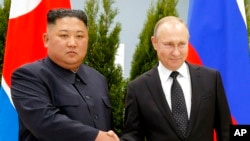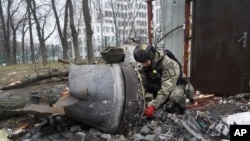The discovery of a North Korean missile in Ukraine that had more than 200 components from U.S. and European companies revealed loopholes that North Korea uses to evade sanctions, said analysts.
North Korea is operating its arms factories at full capacity to supply Russia with weapons needed to fight Ukraine, said South Korean Defense Minister Shin Wonsik at a news briefing on Monday.
South Korea estimates Pyongyang sent about 6,700 containers to Russia since September, Shin said, according to South Korean media.
The U.S. puts the number even higher, estimating that North Korea delivered more than 10,000 containers of munitions or munition-related materials to Russia since September.
The U.S. announced the estimates on Friday as it issued sanctions against more than 500 individuals and entities in Russia.
North Korean weapons have been turning up on the Ukraine battlefield since December, according to the Security Service of Ukraine. It said on Thursday that Russia has fired at least 20 North Korean missiles at Ukraine since then, adding that the missiles had killed or injured civilians.
Russia denied any military or technical cooperation with North Korea during a Jan. 26 news briefing conducted by Foreign Ministry spokesperson Maria Zakharova.
VOA contacted the North Korean mission at the United Nations in New York City for comment but received no response.
Investigators determined a missile recovered on Jan. 2 in Kharkiv, Ukraine's second-largest city, was made with components from U.S. and European companies, according to a report by the U.K.-based investigative group Conflict Armament Research (CAR), first reported by CNN on Feb. 20.
The CAR report found that of the 290 components from the North Korean missile that were examined, about 75% originated with U.S.-based companies. About 16% of the components were linked to European companies.
The report said more than three quarters of the components were produced between 2021 and 2023 and that the missile could not have been made before March 2023. The report said, however, CAR "will not identify the companies linked to their production."
U.N. member states have been banned from exporting materials and technologies that North Korea could use to make ballistic missiles since the Security Council passed Resolution 1718 in 2006.
Experts said U.S. companies whose parts ended up in the North Korean missile probably did not know the identity of the end user.
Aaron Arnold, a former member of the U.N. Panel of Experts for North Korea's sanctions, said, however, that the discoveries show "how porous Western export control systems can be."
Arnold, who is currently a senior associate fellow at Centre for Financial Crime and Security Studies at the Royal United Service Institute, told VOA via email on Friday that some of the items that ended up in the North Korean missile are items that can be used to make weapons as well as commercial goods.
"While I can't say for sure in this particular case, some of the micro-electronics are dual use, meaning, they could be commonplace and used in other commercial applications," Arnold said. "Some of the Western micro-electronics found in Russian drones, for example, are also used in refrigerators."
Bruce Klingner, senior research fellow for Northeast Asia at the Heritage Foundation, emailed VOA on Monday that in addition to dual-use items, "the focus on sanctions enforcement should be on more important components."
Such components could include "non-domestic electronic components" that the CAR report said were found in the North Korean missile.
Arnold and other experts said North Korea's practice of using third-party countries to smuggle banned items makes it difficult to detect components headed into the country. But they said it is possible to use established procurement networks to track components back from the missile to identify intermediaries.
Anthony Ruggiero, senior fellow and sanctions expert at the Foundation for Defense of Democracies, said in a telephone interview with VOA on Friday, "Part of the biggest challenge is going after those who help North Korean sanctions evasion."
He continued, "China, Russia, North Korea, Iran — these countries are experts in avoiding U.N. and U.S. sanctions. They are smart enough not to use their names and avoid any suggestion that it's Russia or North Korea or Iran or China trying to buy these items. Part of the challenge is to lift that veil."
Joshua Stanton, an attorney based in Washington who helped draft the Sanctions and Policy Enforcement Act in 2016, said via email these discoveries could be "an opportunity for the Commerce Department to trace North Korea's procurement networks from each component through its supply chain and put the middlemen on its entity list."













